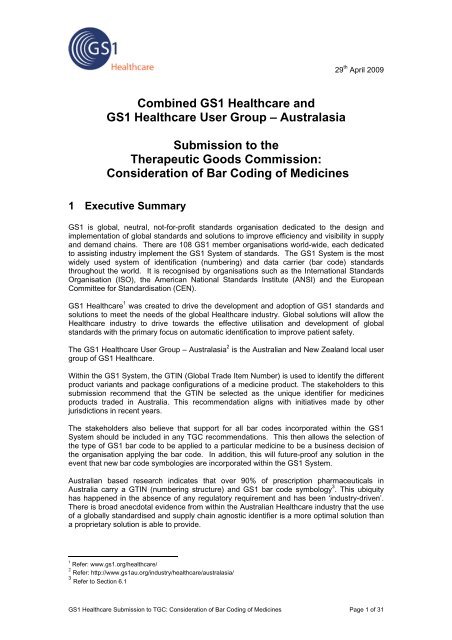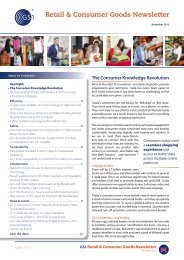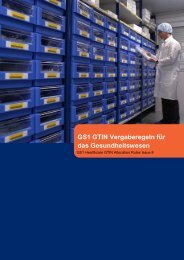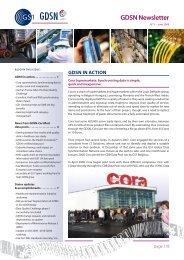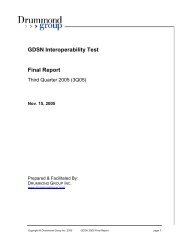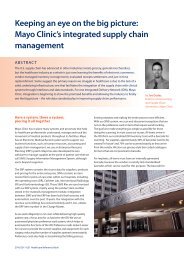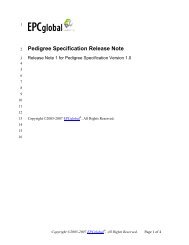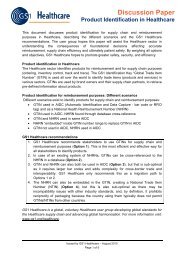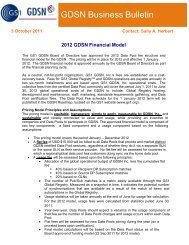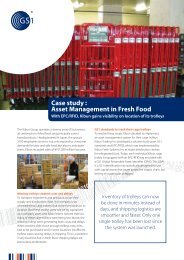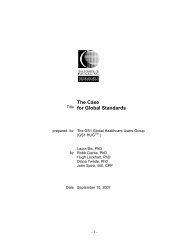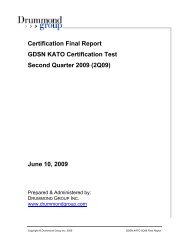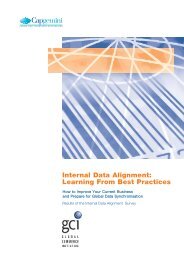Combined GS1 Healthcare and GS1 Healthcare User Group ...
Combined GS1 Healthcare and GS1 Healthcare User Group ...
Combined GS1 Healthcare and GS1 Healthcare User Group ...
You also want an ePaper? Increase the reach of your titles
YUMPU automatically turns print PDFs into web optimized ePapers that Google loves.
29 th April 2009<br />
<strong>Combined</strong> <strong>GS1</strong> <strong>Healthcare</strong> <strong>and</strong><br />
<strong>GS1</strong> <strong>Healthcare</strong> <strong>User</strong> <strong>Group</strong> – Australasia<br />
Submission to the<br />
Therapeutic Goods Commission:<br />
Consideration of Bar Coding of Medicines<br />
1 Executive Summary<br />
<strong>GS1</strong> is global, neutral, not-for-profit st<strong>and</strong>ards organisation dedicated to the design <strong>and</strong><br />
implementation of global st<strong>and</strong>ards <strong>and</strong> solutions to improve efficiency <strong>and</strong> visibility in supply<br />
<strong>and</strong> dem<strong>and</strong> chains. There are 108 <strong>GS1</strong> member organisations world-wide, each dedicated<br />
to assisting industry implement the <strong>GS1</strong> System of st<strong>and</strong>ards. The <strong>GS1</strong> System is the most<br />
widely used system of identification (numbering) <strong>and</strong> data carrier (bar code) st<strong>and</strong>ards<br />
throughout the world. It is recognised by organisations such as the International St<strong>and</strong>ards<br />
Organisation (ISO), the American National St<strong>and</strong>ards Institute (ANSI) <strong>and</strong> the European<br />
Committee for St<strong>and</strong>ardisation (CEN).<br />
<strong>GS1</strong> <strong>Healthcare</strong> 1 was created to drive the development <strong>and</strong> adoption of <strong>GS1</strong> st<strong>and</strong>ards <strong>and</strong><br />
solutions to meet the needs of the global <strong>Healthcare</strong> industry. Global solutions will allow the<br />
<strong>Healthcare</strong> industry to drive towards the effective utilisation <strong>and</strong> development of global<br />
st<strong>and</strong>ards with the primary focus on automatic identification to improve patient safety.<br />
The <strong>GS1</strong> <strong>Healthcare</strong> <strong>User</strong> <strong>Group</strong> – Australasia 2 is the Australian <strong>and</strong> New Zeal<strong>and</strong> local user<br />
group of <strong>GS1</strong> <strong>Healthcare</strong>.<br />
Within the <strong>GS1</strong> System, the GTIN (Global Trade Item Number) is used to identify the different<br />
product variants <strong>and</strong> package configurations of a medicine product. The stakeholders to this<br />
submission recommend that the GTIN be selected as the unique identifier for medicines<br />
products traded in Australia. This recommendation aligns with initiatives made by other<br />
jurisdictions in recent years.<br />
The stakeholders also believe that support for all bar codes incorporated within the <strong>GS1</strong><br />
System should be included in any TGC recommendations. This then allows the selection of<br />
the type of <strong>GS1</strong> bar code to be applied to a particular medicine to be a business decision of<br />
the organisation applying the bar code. In addition, this will future-proof any solution in the<br />
event that new bar code symbologies are incorporated within the <strong>GS1</strong> System.<br />
Australian based research indicates that over 90% of prescription pharmaceuticals in<br />
Australia carry a GTIN (numbering structure) <strong>and</strong> <strong>GS1</strong> bar code symbology 3 . This ubiquity<br />
has happened in the absence of any regulatory requirement <strong>and</strong> has been ‘industry-driven’.<br />
There is broad anecdotal evidence from within the Australian <strong>Healthcare</strong> industry that the use<br />
of a globally st<strong>and</strong>ardised <strong>and</strong> supply chain agnostic identifier is a more optimal solution than<br />
a proprietary solution is able to provide.<br />
1<br />
Refer: www.gs1.org/healthcare/<br />
2 Refer: http://www.gs1au.org/industry/healthcare/australasia/<br />
3 Refer to Section 6.1<br />
<strong>GS1</strong> <strong>Healthcare</strong> Submission to TGC: Consideration of Bar Coding of Medicines Page 1 of 31
29 th April 2009<br />
Our strong recommendation is for the TGC to reference the position <strong>and</strong> recommendations of<br />
industry, existing work of other Government organisations, e.g., NEHTA, <strong>and</strong> also the policies<br />
<strong>and</strong> recommendations from other <strong>Healthcare</strong> jurisdictions, many of whom are either moving<br />
towards or have implemented the <strong>GS1</strong> System.<br />
The stakeholders recognise that a collaborative approach is both necessary <strong>and</strong> desirable. As<br />
such, we emphasise our commitment to working collaboratively with the TGC to aid the<br />
development of a st<strong>and</strong>ardised medicines identification <strong>and</strong> bar coding policy that will benefit<br />
all <strong>Healthcare</strong> stakeholders throughout Australia.<br />
<strong>GS1</strong> <strong>Healthcare</strong> Submission to TGC: Consideration of Bar Coding of Medicines Page 2 of 31
29 th April 2009<br />
Table of Contents<br />
1 Executive Summary.......................................................................................................... 1<br />
2 Background to this Submission ........................................................................................ 4<br />
3 Stakeholders ..................................................................................................................... 4<br />
4 Contact.............................................................................................................................. 4<br />
5 Background....................................................................................................................... 5<br />
5.1 Who is <strong>GS1</strong>? ............................................................................................................ 5<br />
5.2 What is <strong>GS1</strong> <strong>Healthcare</strong>?......................................................................................... 5<br />
5.3 What is the <strong>GS1</strong> <strong>Healthcare</strong> <strong>User</strong> <strong>Group</strong> – Australasia?......................................... 6<br />
5.4 What is the <strong>GS1</strong> System? ........................................................................................ 6<br />
5.5 How does the <strong>GS1</strong> System enable Identification <strong>and</strong> Bar Coding of Medicines? ... 7<br />
6 Specific Information Requested........................................................................................ 8<br />
6.1 Current levels of Bar Coding within the Australian Medicines Sector...................... 8<br />
6.2 Exemption / Waiver Process .................................................................................... 9<br />
6.3 The extent of use of other bar coding systems, e.g. non-<strong>GS1</strong>, in the sector........... 9<br />
6.4 Product details currently encoded within the bar code ............................................ 9<br />
6.5 Current purposes for bar coding ............................................................................ 10<br />
6.6 Future potential purposes for bar coding ............................................................... 11<br />
6.7 Types of Bar Codes / Data Carriers – Now <strong>and</strong> Future ......................................... 11<br />
6.8 Considerations for implementation of more complex data carriers........................ 12<br />
7 Other Considerations...................................................................................................... 14<br />
7.1 Support for Industry................................................................................................ 14<br />
7.2 International regulatory practice / Harmonisation with other countries.................. 14<br />
7.3 NEHTA Supply Chain Initiative .............................................................................. 14<br />
7.4 Radio Frequency Identification............................................................................... 15<br />
7.5 Industry Developed Guidelines <strong>and</strong> St<strong>and</strong>ards...................................................... 15<br />
7.6 Level of bar coding of complementary medicines.................................................. 16<br />
7.7 Identification of different levels of packaging ......................................................... 16<br />
8 Conclusion ...................................................................................................................... 17<br />
9 Appendix ......................................................................................................................... 18<br />
<strong>GS1</strong> <strong>Healthcare</strong> Submission to TGC: Consideration of Bar Coding of Medicines Page 3 of 31
29 th April 2009<br />
2 Background to this Submission<br />
<strong>GS1</strong> Australia was recently provided with a copy of the written communication between the<br />
Therapeutic Goods Committee (TGC) secretary Lyn Lewis <strong>and</strong> Ian Chalmers, CEO,<br />
Medicines Australia, as well as a copy of the communication from Ian Chalmers to Medicines<br />
Australia members asking for their input <strong>and</strong> assistance to the TGC’s work.<br />
At the request of pharmaceutical manufacturers <strong>and</strong> other industry participants, <strong>GS1</strong> Australia<br />
has coordinated this submission on behalf of the organisations listed in Section 3.<br />
In preparing this submission, the stakeholders have emphasised their wish to work<br />
collaboratively with the TGC to aid the development of a medicines identification <strong>and</strong> bar<br />
coding policy that will leverage work already being undertaken within the sector <strong>and</strong> ultimately<br />
benefit the complete <strong>Healthcare</strong> supply chain. We hope that the TGC will make use of the<br />
combined knowledge <strong>and</strong> expertise of the stakeholders in arriving at an optimal solution for<br />
Australia.<br />
3 Stakeholders<br />
The following organisations have all provided input to this submission.<br />
• <strong>GS1</strong> <strong>Healthcare</strong><br />
• <strong>GS1</strong> <strong>Healthcare</strong> Public Policy Work Team<br />
• Leadership team of the <strong>GS1</strong> <strong>Healthcare</strong> <strong>User</strong> <strong>Group</strong> Australasia, comprising:<br />
o Clifford Hallam <strong>Healthcare</strong> (CH2) – <strong>Group</strong> Chair<br />
o Douglas Pharmaceuticals Ltd<br />
o <strong>GS1</strong> Australia<br />
o <strong>GS1</strong> New Zeal<strong>and</strong><br />
o Pfizer Australia<br />
o South Australia Health<br />
o Terumo Australia<br />
4 Contact<br />
Primary contact <strong>and</strong> additional information relating to this submission, please contact:<br />
Tania Snioch<br />
Industry Manager – <strong>Healthcare</strong><br />
<strong>GS1</strong> Australia<br />
03 9550 3473<br />
tsnioch@gs1au.org<br />
<strong>GS1</strong> <strong>Healthcare</strong> Submission to TGC: Consideration of Bar Coding of Medicines Page 4 of 31
29 th April 2009<br />
5 Background<br />
5.1 Who is <strong>GS1</strong>?<br />
<strong>GS1</strong> is a global, neutral, not-for-profit organisation dedicated to the design <strong>and</strong><br />
implementation of global st<strong>and</strong>ards <strong>and</strong> solutions to improve efficiency <strong>and</strong> visibility in supply<br />
<strong>and</strong> dem<strong>and</strong> chains. <strong>GS1</strong> <strong>and</strong> its subsidiaries <strong>and</strong> partnerships connect companies with<br />
st<strong>and</strong>ards-based solutions that are open, consensus-based <strong>and</strong> universally endorsed. From<br />
bar codes, electronic messaging, data synchronisation, radio frequency identification, to<br />
business process automation st<strong>and</strong>ards, <strong>GS1</strong> is the trusted source to deliver innovative<br />
st<strong>and</strong>ards, services <strong>and</strong> solutions for business’ most pressing supply chain challenges. <strong>GS1</strong><br />
is a fully integrated global organisation, with 108 Member Organisations serving over a million<br />
companies doing business across 145 countries.<br />
5.2 What is <strong>GS1</strong> <strong>Healthcare</strong>?<br />
Globally, <strong>GS1</strong> supports the <strong>Healthcare</strong> community through its <strong>GS1</strong> <strong>Healthcare</strong> initiative. <strong>GS1</strong><br />
<strong>Healthcare</strong> is a voluntary, global user community bringing together all <strong>Healthcare</strong><br />
stakeholders, including: pharmaceutical <strong>and</strong> medical devices manufacturers, wholesalers <strong>and</strong><br />
distributors, group purchasing organisations, hospitals, pharmacies, logistics providers,<br />
governmental <strong>and</strong> regulatory bodies <strong>and</strong> associations.<br />
<strong>GS1</strong> <strong>Healthcare</strong> was created to drive the development of <strong>GS1</strong> st<strong>and</strong>ards <strong>and</strong> solutions to<br />
meet the needs of the global <strong>Healthcare</strong> industry, <strong>and</strong> to allow the <strong>Healthcare</strong> industry to drive<br />
the effective utilisation <strong>and</strong> development of global st<strong>and</strong>ards with the primary focus on<br />
automatic identification to improve patient safety. The objectives of <strong>GS1</strong> <strong>Healthcare</strong> are to:<br />
• Work with key partners in the global <strong>Healthcare</strong> supply chain to develop <strong>and</strong> optimise<br />
the use of global st<strong>and</strong>ards to enhance accurate <strong>and</strong> fast movement of goods from<br />
manufacturer to distributor to <strong>Healthcare</strong> providers (such as hospitals or retail<br />
pharmacies).<br />
• Facilitate awareness in the <strong>Healthcare</strong> sector of new technologies <strong>and</strong> methods of<br />
doing e-business.<br />
• Provide advice <strong>and</strong> recommendations to <strong>GS1</strong> on issues <strong>and</strong> opportunities in the<br />
<strong>Healthcare</strong> sector.<br />
• Promote best practice implementation of the <strong>GS1</strong> System in the <strong>Healthcare</strong> industry.<br />
• Promote the implementation of <strong>GS1</strong> voluntary, global business st<strong>and</strong>ards throughout<br />
the <strong>Healthcare</strong> sector.<br />
There are currently over 300 participants in <strong>GS1</strong> <strong>Healthcare</strong>, representing over 150<br />
companies, including thirty of the forty largest global manufacturers. The group was formed in<br />
association with leading industry groups <strong>and</strong> associations <strong>and</strong> benefits from the active<br />
participation from all key supply chain roles (i.e., manufacturers, distributors, retailers, <strong>and</strong><br />
hospitals/providers) 4 .<br />
4 Refer: http://www.gs1.org/sectors/healthcare/<br />
<strong>GS1</strong> <strong>Healthcare</strong> Submission to TGC: Consideration of Bar Coding of Medicines Page 5 of 31
29 th April 2009<br />
5.3 What is the <strong>GS1</strong> <strong>Healthcare</strong> <strong>User</strong> <strong>Group</strong> – Australasia?<br />
The <strong>GS1</strong> <strong>Healthcare</strong> <strong>User</strong> <strong>Group</strong> – Australasia is the Australian <strong>and</strong> New Zeal<strong>and</strong> local user<br />
group of <strong>GS1</strong> <strong>Healthcare</strong>, the <strong>GS1</strong> global <strong>Healthcare</strong> user group. This local group comprises<br />
over 50 representatives from <strong>Healthcare</strong> organisations operating in the Australian <strong>and</strong> New<br />
Zeal<strong>and</strong> markets, who wish to ensure they have the opportunity to input to the work being<br />
undertaken by <strong>GS1</strong> <strong>Healthcare</strong> for the benefit of the global <strong>Healthcare</strong> community 5 .<br />
5.4 What is the <strong>GS1</strong> System?<br />
The <strong>GS1</strong> System is the most widely used system of identification (numbering) <strong>and</strong> data<br />
carrier (bar code) st<strong>and</strong>ards throughout the world. Over 1.5 million users across 145 countries<br />
<strong>and</strong> more than 24 industry sectors have adopted the <strong>GS1</strong> System. It is recognised by<br />
organisations such as the International St<strong>and</strong>ards Organisation (ISO), the American National<br />
St<strong>and</strong>ards Institute (ANSI) <strong>and</strong> the European Committee for St<strong>and</strong>ardisation (CEN).<br />
At its most fundamental level, the <strong>GS1</strong> System is an integrated suite of global st<strong>and</strong>ards that<br />
provides for accurate identification <strong>and</strong> communication of information regarding products,<br />
assets, services <strong>and</strong> locations. Using <strong>GS1</strong> Identification Numbers, companies around the<br />
world are able to globally <strong>and</strong> uniquely identify physical items like trade items, assets, logistic<br />
units, shipments, <strong>and</strong> physical locations, as well as logical items like corporations or a service<br />
relationship between provider <strong>and</strong> recipient. When this identification system is combined with<br />
<strong>GS1</strong> data carriers, electronic business messages, data synchronisation via the National<br />
Product Catalogue (NPC) in Australia <strong>and</strong> the Global Data Synchronisation Network (GDSN)<br />
worldwide, the connection is made between these physical or logical items <strong>and</strong> information<br />
the supply chain needs about them.<br />
The <strong>GS1</strong> System is:<br />
- Open: the <strong>GS1</strong> st<strong>and</strong>ards development process is user-driven which permits full<br />
interoperability <strong>and</strong> compatibility <strong>and</strong> ensures end users are not locked into proprietary<br />
often inflexible solutions.<br />
- Global: <strong>Healthcare</strong> is by nature a global sector, with supply chains that often cross<br />
national borders. On the other h<strong>and</strong>, <strong>Healthcare</strong> is also very much local. The <strong>GS1</strong><br />
st<strong>and</strong>ards development process ensures that local needs are incorporated into global<br />
st<strong>and</strong>ards.<br />
- Proven: the <strong>GS1</strong> System has been used for over 30 years in different industry sectors all<br />
over the world ensuring its robustness <strong>and</strong> reliability, including built-in security <strong>and</strong><br />
privacy (e.g. identification numbers are non-significant - they identify an item but contain<br />
no information about it).<br />
It is widely accepted that the use of <strong>GS1</strong> st<strong>and</strong>ards improves patient safety <strong>and</strong> reduces costs<br />
in the global <strong>Healthcare</strong> supply chain. It enables traceability <strong>and</strong> promotes a safe <strong>and</strong> secure<br />
supply chain by providing greater visibility, accuracy <strong>and</strong> efficiency for the benefit of all parties<br />
involved. Preventing medical errors <strong>and</strong> combating counterfeiting are top-of-mind concerns<br />
facing the <strong>Healthcare</strong> sector, <strong>and</strong> <strong>GS1</strong> st<strong>and</strong>ards are helping to solve these issues.<br />
5 Refer: http://www.gs1au.org/industry/healthcare/australasia/<br />
<strong>GS1</strong> <strong>Healthcare</strong> Submission to TGC: Consideration of Bar Coding of Medicines Page 6 of 31
29 th April 2009<br />
5.5 How does the <strong>GS1</strong> System enable Identification <strong>and</strong> Bar Coding of<br />
Medicines?<br />
For the purpose of this submission, the identification of medicines i.e., unique <strong>and</strong><br />
unambiguous numbering of different levels of packaging of a medicine product, <strong>and</strong> bar<br />
coding of these medicines are considered two independent concepts, the reasons for which<br />
are outlined below.<br />
5.5.1 Identification of Medicines Products<br />
Within the <strong>GS1</strong> System, the GTIN (Global Trade Item Number) is used to identify the different<br />
product variants <strong>and</strong> package configurations of a medicine product. A change to one aspect,<br />
characteristic, variant or formulation of a medicine may require the allocation of a new GTIN.<br />
<strong>GS1</strong> <strong>Healthcare</strong> has produced a guide to GTIN allocation for <strong>Healthcare</strong> items 6 . This guide<br />
clearly outlines both medicines <strong>and</strong> other <strong>Healthcare</strong> related products <strong>and</strong> provides a<br />
comprehensive reference to organisations responsible for GTIN allocation.<br />
Integrity of the GTIN throughout the medicine product’s lifetime is key to maintaining accurate<br />
identification of products by manufacturers, wholesalers, distributors, hospitals, regulatory<br />
bodies <strong>and</strong> other supply chain stakeholders, irrespective of their country or region.<br />
Our submission recommends that the GTIN, using the <strong>GS1</strong> System, be selected as the<br />
unique medicines identifier for products traded in Australia.<br />
5.5.2 Bar Coding Medicines Products<br />
When considering the appropriate bar code to apply to a medicine product, the organisation<br />
applying the bar code (generally the br<strong>and</strong> owner or manufacturer) has a number of<br />
considerations, including:<br />
• Available label space for application of the bar code.<br />
• Type of substrate onto which the bar code is being applied.<br />
• The need to include information additional to the GTIN (e.g., batch or expiry date) in<br />
the bar code.<br />
• Manufacturer printing abilities (e.g., is a linear bar code more appropriate than a 2<br />
dimensional – <strong>GS1</strong> DataMatrix – bar code).<br />
• Bar code reading capabilities of supply chain partners, e.g., wholesalers, hospitals,<br />
pharmacies.<br />
The <strong>GS1</strong> System currently includes five bar code formats, providing flexibility for trading<br />
partners in selecting the best bar code for their application. Each of the <strong>GS1</strong> symbologies or<br />
formats have a common global st<strong>and</strong>ard method by which information (e.g., GTIN plus<br />
additional information, if applicable) can be encoded 7 . This ensures that <strong>GS1</strong> st<strong>and</strong>ards<br />
function on the premise that the best way to determine the right bar code for a product is to<br />
have a user driven, global process (where bar code selections are based on considerations<br />
such as those highlighted above). The <strong>GS1</strong> System provides guidelines for selection,<br />
structure <strong>and</strong> placement to assist this decision.<br />
Bar code scanners sold today are pre-programmed to support all open st<strong>and</strong>ard <strong>GS1</strong> bar<br />
code symbologies, thus enabling the manufacturer’s right to assess their product <strong>and</strong> make<br />
an unconstrained decision about the applicable type of <strong>GS1</strong> bar code.<br />
6 Refer: http://www.gs1.org/gtinrules/index.php/p=static/t=healthcare.<br />
7 Refer Section 6.8<br />
<strong>GS1</strong> <strong>Healthcare</strong> Submission to TGC: Consideration of Bar Coding of Medicines Page 7 of 31
29 th April 2009<br />
It is also important to note that one key principle of the <strong>GS1</strong> System is that the bar coded<br />
data is simply a pointer to a record contained in a data base. This means the amount of<br />
information carried in the bar code should be the minimum needed to look-up <strong>and</strong> access<br />
that database, but also sufficient to enable capturing of item specific information (e.g., batch<br />
<strong>and</strong> expiry date) for traceability purposes.<br />
Overall, it is the belief of the stakeholders of this submission that support for all bar codes<br />
incorporated within the <strong>GS1</strong> System should be included in any TGC recommendations. This<br />
then allows the selection of the type of <strong>GS1</strong> bar code to be applied to a particular medicine to<br />
be a business decision of the organisation applying the bar code.<br />
6 Specific Information Requested<br />
6.1 Current levels of Bar Coding within the Australian Medicines Sector<br />
Within the last few years, three studies of the penetration / use of <strong>GS1</strong> identification <strong>and</strong> <strong>GS1</strong><br />
bar coding of medicines in Australia have been undertaken. The results of these (below)<br />
illustrate a trend to the increased use of <strong>GS1</strong> bar codes for pharmaceuticals in Australia.<br />
• Survey 1: 2001<br />
o Location: Hunter Area Health Service Distribution Centre<br />
o Scope: All products in the Distribution Centre<br />
o Result: 85% of pharmaceutical box/each level units carried <strong>GS1</strong> bar codes<br />
• Survey 2: 2003<br />
o Location: Monash Medical Centre Hospital Pharmacy, Victoria.<br />
o Scope: All products in stock at the hospital pharmacy<br />
o Result: 89% of box/each level units carried <strong>GS1</strong> bar codes, 26% of inners<br />
(shrink wrap) or shippers (cartons) carried <strong>GS1</strong> bar codes<br />
• Survey 3: 2005<br />
o Location: Clifford Hallam Pharmaceuticals (CHP, prior to merging with<br />
Hospital Supplies of Australia <strong>and</strong> becoming Clifford Hallam <strong>Healthcare</strong>).<br />
o Scope: This survey involved audit of a subset of products in the CHP<br />
warehouse.<br />
o Result: 93% of box/each level units carried <strong>GS1</strong> bar codes.<br />
Based on the above results, the stakeholders believe that information provided to the TGC<br />
from the Pharmacy Board of Victoria, indicating that up to 10% of prescription medicines (at<br />
box/each level) do not carry bar codes, would be reasonably accurate. However, this also<br />
identifies that over 90% of prescription pharmaceuticals do carry GTINs <strong>and</strong> <strong>GS1</strong> bar codes -<br />
an excellent proportion considering there has been no Australian policy requiring identification<br />
<strong>and</strong> bar coding of these products, <strong>and</strong> a testament to the enormous voluntary uptake of a<br />
global solution within the <strong>Healthcare</strong> user community.<br />
There is very little bar coding of medicine product at higher levels of packaging (ie, shrink<br />
wrap, case, shipper) <strong>and</strong> this is certainly an area where bar coding related policy would<br />
facilitate implementation, <strong>and</strong> benefit industry by enabling introduction of traceability systems<br />
within the sector. For more information, refer to Section 7.7.<br />
<strong>GS1</strong> <strong>Healthcare</strong> Submission to TGC: Consideration of Bar Coding of Medicines Page 8 of 31
29 th April 2009<br />
6.2 Exemption / Waiver Process<br />
Our recommendation is to include provision for a formal Waiver or Exemption process in any<br />
planned regulation / policy as it may be difficult to mark every pharmaceutical product with a<br />
bar code.<br />
a. Products might be too small, have no label space or even have no label.<br />
b. Manufacturer / Br<strong>and</strong> Owner should be provided the opportunity to request<br />
exemptions or waivers for specific products based on facts submitted.<br />
c. At minimum, the following categories of drug products should be considered as<br />
complex <strong>and</strong> potentially subject to waiver.<br />
1. Kits that contain any drug product<br />
2. Combination Drug / Device<br />
3. Drug products that are custom-made for a specific patient (such as antiallergy<br />
extracts manufactured for one patient)<br />
However, it should be noted that any limitations preventing physical bar coding do not<br />
prevent allocation of a GTIN to that particular item at that level of packaging.<br />
6.3 The extent of use of other bar coding systems, e.g. non-<strong>GS1</strong>, in the<br />
sector<br />
The 2003 study 8 conducted by <strong>GS1</strong> Australia, indicated that the only application of alternate<br />
identification <strong>and</strong> bar coding of medicines products was ‘internal / proprietary’ bar coding<br />
found only 1% of the shipper / case level packaging assessed. There was no alternate bar<br />
coding used for each / box packaging – the products either carried <strong>GS1</strong> bar codes or no bar<br />
code.<br />
Strong anecdotal evidence from industry representatives supports the above finding <strong>and</strong> so it<br />
is the conclusion of the stakeholders to this submission that the only identification <strong>and</strong> bar<br />
coding st<strong>and</strong>ard used in the medicines sector today is <strong>GS1</strong>.<br />
6.4 Product details currently encoded within the bar code<br />
Currently each / box unit pharmaceuticals in Australia carry a bar code containing the <strong>GS1</strong><br />
GTIN only.<br />
Higher level packaging, e.g., shrink wrap, case, shipper, may carry bar codes that contain the<br />
GTIN plus attribute information such as batch / lot number, expiry date, serial number, etc.<br />
The provision of this additional information is currently at the discretion of the manufacturer /<br />
organisation applying the bar code, <strong>and</strong> often this information is used internally within the<br />
manufacturer’s business for traceability functions.<br />
Where additional information exists, this is starting to be used by pharmaceutical wholesalers<br />
wishing to enable traceability within their own businesses.<br />
It is the recommendation of the stakeholders that the focus be placed on allocation of GTINs<br />
<strong>and</strong> physical bar coding at all levels of packaging (as appropriate) as a first step for any policy<br />
introduced. A longer term focus would then be provision of attribute information, e.g., batch<br />
<strong>and</strong> expiry date, that may be applied to the box / each or higher level packaging.<br />
8 Refer to Section 6.1<br />
<strong>GS1</strong> <strong>Healthcare</strong> Submission to TGC: Consideration of Bar Coding of Medicines Page 9 of 31
29 th April 2009<br />
6.5 Current purposes for bar coding<br />
6.5.1 Australia<br />
The existing uses in Australia of medicines identifiers <strong>and</strong> bar codes include:<br />
• Ensuring accurate dispensing to hospital pharmacy outpatients via a ‘scan<br />
dispensing’ process, whereby the bar code on the box / each being dispensed is<br />
scanned <strong>and</strong> matched against the patient record. This ensures the right patient<br />
receives the right drugs, <strong>and</strong> facilitates this occurring at the right time. A number of<br />
retail pharmacies in Australia also undertake the above process.<br />
• Stocktake for imprest in hospital wards, where the bar code on the medicine is<br />
scanned at the ward imprest location for identification <strong>and</strong> re-ordering.<br />
• Confirmation of accurate picking for imprest replenishment in the hospital pharmacy<br />
stores, i.e., scanning the bar codes on the packs so that picking of the correct<br />
quantity of the correct product for a particular ward can be verified.<br />
• Within wholesalers <strong>and</strong> distributors, scan receiving goods into organisations, either at<br />
each / box or case level for recording receipt, stock put away, etc. Also scan picking<br />
<strong>and</strong> packing is used within wholesalers <strong>and</strong> distributors to ensure accurate shipments<br />
are being collated.<br />
6.5.2 International<br />
Internationally, whilst all of the activities mentioned in Section 6.5.1 occur, there is a greater<br />
focus on scanning medicines bar codes at the patient bed side or in the operating theatre to<br />
ensure improved patient safety in hospitals.<br />
A clear indication of the business case for such work has been developed in New Zeal<strong>and</strong>,<br />
where an estimated 150 people die each year from medication error <strong>and</strong> approximately 4000<br />
others are temporarily or permanently disabled. 9<br />
Likewise studies conducted both in the US <strong>and</strong> Netherl<strong>and</strong>s clearly indicate the patient safety<br />
benefits. At Gelre Hospitals, Apeldoorn in the Netherl<strong>and</strong>s, introduction of a bar code<br />
scanning process at patient bedside resulted in a 50% reduction in dispensing errors 10 . A<br />
dispensing error is identified as a ‘difference between what was prescribed by the<br />
physician <strong>and</strong> what is actually administered to the patient’ 11 .<br />
In the US, at Brigham <strong>and</strong> Women’s Hospital, implementation of bar code scanning in the<br />
pharmacy resulted in significant reductions in dispensing <strong>and</strong> administration errors. Prior to<br />
implementation, approximately 3% of the medicines issued to the patient were incorrect in the<br />
areas of type, strength or form. Post implementation of bar code scanning, there was an<br />
overall 85% reduction in the instance of these errors. 12<br />
Other countries such as France, Japan, Korea, amongst others have or are about to release<br />
policy relating to bar coding of medicines to ensure patient safety at the bedside.<br />
This area seems to be a lower priority focus in Australia today, but is certainly an opportunity.<br />
For information about overall identification <strong>and</strong> bar coding policy, much can be learned from<br />
the work of the National Health Service (NHS) in Engl<strong>and</strong>. This organisation has embarked<br />
9 Anderson, B., Improving Medication Safety: Bedside Verification, Draft Project Outline, 20 th August 2007, p5<br />
10 Ros, H., Bedside assortment picking – Decreasing the number of dispensing errors by implementing CPOE <strong>and</strong><br />
bar code assisted dispensing, Presentation to <strong>GS1</strong> <strong>Healthcare</strong> Conference, London, 29 th October 2008<br />
11 Ibid<br />
12 Cooley, T.W., Implementing barcode technology strategies to improve patient care: impact <strong>and</strong> lessons learned,<br />
International Hospital Federation Reference Book, 2007/2008, p36<br />
<strong>GS1</strong> <strong>Healthcare</strong> Submission to TGC: Consideration of Bar Coding of Medicines Page 10 of 31
29 th April 2009<br />
on an ambitious programme to use Automatic Data Capture Technologies (AIDC) throughout<br />
Engl<strong>and</strong>’s <strong>Healthcare</strong> sector which is foundational on <strong>GS1</strong> st<strong>and</strong>ards <strong>and</strong> identifiers. The well<br />
publicised <strong>and</strong> referenced ‘Coding for Success’ document is seen by many <strong>Healthcare</strong><br />
jurisdictions as a global industry template for st<strong>and</strong>ardised coding because of the benefits it<br />
promises to deliver to <strong>Healthcare</strong> outcomes 13 .<br />
After undertaking extensive research into the use of potential coding systems for Engl<strong>and</strong>, the<br />
NHS Purchasing <strong>and</strong> Supply Agency (NHS PASA) identified <strong>and</strong> recommended to all<br />
<strong>Healthcare</strong> sector stakeholders that the <strong>GS1</strong> System (then known as EAN.UCC) was the<br />
preferred solution 14 .<br />
6.6 Future potential purposes for bar coding<br />
In the future, Australian organisations will have the opportunity to focus the use of medicines<br />
identification <strong>and</strong> bar codes on more advanced applications, including:<br />
• The use of bar code scanning at the patient bedside <strong>and</strong> in the operating theatre.<br />
This may mean that future initiatives could involve identification <strong>and</strong> bar coding of<br />
medicines to unit dose level, i.e., the individual pill or capsule blister.<br />
• Bar code scanning in the patient home for self-medication management could<br />
become a focus. At the St James Hospital, Irel<strong>and</strong>, a bar coding application has<br />
been deployed for haemophiliacs managing a stock of clotting agents in their own<br />
homes. This application uses <strong>GS1</strong> bar codes for traceability (i.e., Are products within<br />
an applicable batch <strong>and</strong> expiry range?), as well as ensuring patients are selfadministering<br />
the correct product. 15 In the first 12 months since the project was live,<br />
cold chain delivery was able to be verified within the desired temperature range,<br />
product wastage reduced from €90,216 to zero <strong>and</strong> documentation errors were<br />
reduced from 12 to zero.<br />
• Use of bar code scanning for traceability, to ensure the location of medicines can<br />
easily be identified in the case of recall, will be a key area of application. A<br />
manufacturer, distributor, wholesaler, pharmacy or hospital will be able to scan bar<br />
codes to capture traceability information at goods receipt <strong>and</strong> keep a record of the<br />
individual batches within its deliveries. When combined with the information sharing<br />
mechanisms that form part of the <strong>GS1</strong> st<strong>and</strong>ards, this will allow verification <strong>and</strong><br />
authentication of medicines throughout the <strong>Healthcare</strong> supply chain, ensuring both<br />
traceability, <strong>and</strong> that counterfeit product does not enter the market.<br />
6.7 Types of Bar Codes / Data Carriers – Now <strong>and</strong> Future<br />
6.7.1 Current bar code symbologies<br />
Currently, we see that each / box level pharmaceuticals carry a GTIN in either of an EAN-8,<br />
EAN-13, UPC-A or UPC-E bar code symbology. These symbologies are traditionally applied<br />
in a ‘point of sale’ environment in <strong>Healthcare</strong>, but also industry sectors such as Hardware,<br />
Grocery, General Merch<strong>and</strong>ise, Automotive Aftermarket, etc.<br />
Shrink-wrap, shipper or case level packaging that is currently marked with a <strong>GS1</strong> bar code<br />
generally carries a GTIN in an EAN-13 or ITF-14 symbology or alternatively a GTIN <strong>and</strong><br />
attribute information (e.g., batch, expiry date) in a <strong>GS1</strong>-128 symbology.<br />
13 Lovell. H. Department of Health (UK). Coding For Success – Simple Technology for safer patient care. 2007<br />
14 Refer Appendix<br />
15 White, B., Case study: Using an Electronic Patient Record <strong>and</strong> unique medication Bar Coding to deliver integrated<br />
comprehensive patient care for patients with Haemophilia, Presentation.<br />
<strong>GS1</strong> <strong>Healthcare</strong> Submission to TGC: Consideration of Bar Coding of Medicines Page 11 of 31
29 th April 2009<br />
It should be noted that some medicines companies are now moving towards the use of <strong>GS1</strong><br />
DataMatrix, <strong>GS1</strong> DataBar (or a combination of the traditional <strong>GS1</strong> symbologies mentioned<br />
above, together with <strong>GS1</strong> Composite symbology) for marking of each / box level medicines.<br />
This is generally driven by two factors:<br />
1. The organisation’s need to capture information such as the GTIN, batch <strong>and</strong> expiry<br />
date in a bar code form on a small package;<br />
2. The presence of legislation specifically requesting <strong>GS1</strong> DataMatrix symbology be<br />
used to mark all medicines sold to a particular market.<br />
Regulation developed in isolation <strong>and</strong> not with a global harmonised approach is costly <strong>and</strong><br />
difficult to implement. <strong>GS1</strong> <strong>Healthcare</strong> has worked in the last few years to develop Application<br />
St<strong>and</strong>ards detailing identification <strong>and</strong> bar coding principles for all <strong>Healthcare</strong> products. <strong>GS1</strong><br />
<strong>Healthcare</strong> has also worked to align the stakeholders to these global st<strong>and</strong>ards. We would<br />
encourage the TGC to reference the <strong>GS1</strong> <strong>Healthcare</strong> Application St<strong>and</strong>ards in any policy or<br />
regulation that may be developed.<br />
6.7.2 Future bar code symbologies<br />
As with any technology, bar coding will continue to develop, with new bar code symbologies<br />
being released. There are a number of different bar codes included in the <strong>GS1</strong> System for<br />
one good reason - each has specific strengths in solving challenging marking problems.<br />
<strong>GS1</strong>, via the user-driven st<strong>and</strong>ards development process, ensures forward <strong>and</strong> backward<br />
data compatibility as part of the new bar code introduction process while providing flexibility to<br />
adopt new bar codes as they are developed, without need for constant regulatory changes<br />
every time a new bar code is developed.<br />
The stakeholders to this submission have recommended in Section 5.5.2, that the full suite of<br />
bar codes as defined as part of the <strong>GS1</strong> System be supported in any policy or<br />
recommendation made by the TGC. This ensures that the solution recommended is future<br />
proofed <strong>and</strong> that the bar code symbology chosen is appropriate for the product <strong>and</strong> its<br />
function within the <strong>Healthcare</strong> environment.<br />
It should be noted, however, that the primary product identifier, the GTIN, remains constant,<br />
irrespective of the bar code used to encode it.<br />
6.8 Considerations for implementation of more complex data carriers<br />
For the purpose of this submission, more complex data carriers will be defined as any data<br />
carrier that has the ability to encode information additional to the item GTIN. This means that<br />
the EAN-13, EAN-8, UPC-A, UPC-E <strong>and</strong> ITF-14 symbologies supported within the <strong>GS1</strong><br />
System will not be discussed. Rather, <strong>GS1</strong>-128, <strong>GS1</strong> DataBar <strong>and</strong> <strong>GS1</strong> DataMatrix will be<br />
considered.<br />
<strong>GS1</strong>-128 <strong>and</strong> <strong>GS1</strong> DataBar are both linear symbologies, whereas <strong>GS1</strong> DataMatrix is a 2-<br />
dimensional symbology. All of these symbologies have a st<strong>and</strong>ard mechanism by which data<br />
is encoded, using <strong>GS1</strong> Application Identifiers (AIs), which function as field triggers to indicate<br />
to databases the content of the scanned data following the AI.<br />
When implementing these symbologies, the following needs to be considered:<br />
• Scanner capability to read the symbologies<br />
<strong>GS1</strong>-128 symbology has been in the market for over a decade <strong>and</strong> existing scanners have<br />
the capability to read the symbology.<br />
<strong>GS1</strong> <strong>Healthcare</strong> Submission to TGC: Consideration of Bar Coding of Medicines Page 12 of 31
29 th April 2009<br />
<strong>GS1</strong> DataBar has been released to the market in the last few years <strong>and</strong> will become an open<br />
st<strong>and</strong>ard for use by all supply chain partners in 2014. Until that date, <strong>GS1</strong> DataBar can be<br />
implemented between trading partners by bilateral agreement. Scanners sold in the last 3<br />
years are capable of reading <strong>GS1</strong> DataBar <strong>and</strong> slightly older scanners can be upgraded to do<br />
so.<br />
<strong>GS1</strong> DataMatrix, like <strong>GS1</strong> DataBar, has been released to the market in the last few years,<br />
<strong>and</strong> is currently being implemented for niche applications. <strong>GS1</strong> DataMatrix is being<br />
implemented in the <strong>Healthcare</strong> sector by trading partner agreement, much of which is driven<br />
by the release of legislation in certain countries. As this is a two dimensional symbology,<br />
imaging or camera-based scanners are required to read these bar codes, so organisations<br />
looking to scan this symbology will most likely need to upgrade their scanners. Camerabased<br />
scanners will also read the other bar codes supported within the <strong>GS1</strong> st<strong>and</strong>ards, so<br />
there is no requirement for a specific scanner for only one type of symbol. <strong>GS1</strong> <strong>Healthcare</strong><br />
has published recommendations to <strong>Healthcare</strong> organisations, indicating that if companies are<br />
going to upgrade their scanners, they should invest in camera-based scanners. For more<br />
information, refer to<br />
www.gs1.org/hug/about/news/<strong>GS1</strong>_HUG_ps_Camera_Based_Scanners.pdf.<br />
• Database capability to ‘store or ignore’ the additional data<br />
Organisations reading any of the <strong>GS1</strong> bar code symbologies discussed above have the<br />
capacity to ‘store or ignore’ the attribute or additional information contained within the symbol.<br />
This enables a manufacturer to encode in a single symbol all traceability information required<br />
by multiple trading partners. For example, if one trading partner requires GTIN <strong>and</strong> batch<br />
number information, <strong>and</strong> another GTIN <strong>and</strong> expiry date, this could all be implemented in a<br />
single concatenated bar code.<br />
Organisations wishing to store the additional data will need to make a decision to build the<br />
field functionality into their business systems. Many already have the functionality required.<br />
However, having to build or update systems to hold additional data is not a pre-requisite of<br />
using any of the more complex symbologies - If an organisation does not have the capacity to<br />
store certain data, it can be ignored.<br />
• Ability to print these symbologies<br />
Like the appearance of text in a Word document, bar codes are produced based on fonts that<br />
specify the combination of bars <strong>and</strong> spaces (or in the case of <strong>GS1</strong> DataMatrix, boxes) that<br />
represent a character in the symbol. Fonts for all of the <strong>GS1</strong> System supported bar codes are<br />
readily available, both as st<strong>and</strong> alone software to incorporate into existing programs or as part<br />
of commercial ‘bar code software packages’ that can produce bar codes for the entire range<br />
of <strong>GS1</strong> bar codes.<br />
• ‘Print <strong>and</strong> Apply’ versus ‘Pre-Print’<br />
Production of <strong>GS1</strong> bar codes containing information additional to the GTIN requires<br />
application of these bar codes to packaging on a ‘print <strong>and</strong> apply’ basis, rather than mass<br />
production ‘pre-printing’ of packaging. Organisations need to have the ability to apply these<br />
bar codes in a timely manner on the production line, or via other processes.<br />
Where the more complex bar code contains only the GTIN, there is the option to ‘pre-print’ a<br />
quantity of packaging containing the appropriate GTIN <strong>and</strong> bar code, but the benefits of<br />
traceability <strong>and</strong> information capture, resulting from the presence of additional information in<br />
the bar code, are lost.<br />
<strong>GS1</strong> <strong>Healthcare</strong> Submission to TGC: Consideration of Bar Coding of Medicines Page 13 of 31
29 th April 2009<br />
7 Other Considerations<br />
7.1 Support for Industry<br />
A significant part of <strong>GS1</strong> Australia’s charter is to provide support in various forms for<br />
Australian companies, including education & training, implementation assistance <strong>and</strong> industry<br />
user groups. In 2008, <strong>GS1</strong> Australia provided, at no cost to attendees, a telephone/web<br />
based <strong>Healthcare</strong> specific training program around the <strong>GS1</strong> System as well as approximately<br />
ten face to face industry education seminars. In addition, <strong>GS1</strong> Australia provides multiindustry<br />
training, telephone <strong>and</strong> email based support to Australian industry. Therefore, any<br />
recommendation made by the TGC would be fully supported by <strong>GS1</strong> Australia via our industry<br />
programs.<br />
The network of <strong>GS1</strong> member organisations (108 around the world) provide similar support to<br />
their local markets as <strong>GS1</strong> Australia does. Multi-national companies, or organisations<br />
importing product from overseas would find that their head offices / suppliers would have the<br />
information they need to implement any recommendations or policy issued.<br />
7.2 International regulatory practice / Harmonisation with other<br />
countries<br />
A number of countries around the world have regulations in place regarding use of the <strong>GS1</strong><br />
System for identification <strong>and</strong> bar coding of pharmaceuticals. <strong>GS1</strong> <strong>Healthcare</strong> maintains a list<br />
of all of the current regulations <strong>and</strong> should the TGC be interested, can provide this document<br />
for your reference.<br />
In addition, <strong>GS1</strong> <strong>Healthcare</strong> actively works with regulators across the globe to educate <strong>and</strong><br />
advise of industry endorsement of the <strong>GS1</strong> System. <strong>GS1</strong> <strong>Healthcare</strong> sees their role being to<br />
help educate regulators about what members of the sector see as best practice for<br />
identification <strong>and</strong> bar coding, to ensure that any policy developed is undertaken in a<br />
collaborative manner reflecting a global approach.<br />
The stakeholders to this submission believe it is important that any policy or recommendation<br />
released in Australia be in line with that undertaken in other countries to ensure global<br />
interoperability, thus minimising the cost impost on the supply chain <strong>and</strong> ensuring global<br />
medicines traceability.<br />
7.3 NEHTA Supply Chain Initiative<br />
7.3.1 The National Product Catalogue<br />
As recognised in the TGC documentation, the National Product Catalogue (NPC) is being<br />
implemented in Australia as the single repository of product, pricing <strong>and</strong> <strong>Healthcare</strong> data for<br />
all Health industry product categories for the purpose of data synchronisation. The National E-<br />
Health Transition Authority (NEHTA) <strong>and</strong> all State, Territory <strong>and</strong> Federal Health Departments,<br />
endorse the NPC as the 'single source’ of item master data for public health institutions<br />
seeking to purchase medicines, medical devices <strong>and</strong> other necessary <strong>Healthcare</strong> items.<br />
The NPC is part of the <strong>GS1</strong> Global Data Synchronisation Network, a network of data pools<br />
developed to global st<strong>and</strong>ards to allow interoperability. GDSN ensures that organisations<br />
operating in different countries (<strong>and</strong> subscribing to different data pools) have the ability to<br />
synchronise item master data globally <strong>and</strong> so have accurate, complete <strong>and</strong> st<strong>and</strong>ardised data<br />
in their business systems.<br />
<strong>GS1</strong> <strong>Healthcare</strong> Submission to TGC: Consideration of Bar Coding of Medicines Page 14 of 31
29 th April 2009<br />
The NPC is the most advanced implementation of a GDSN compliant data pool in <strong>Healthcare</strong>.<br />
As well as its use in Australia’s public <strong>Healthcare</strong> sector it is also being implemented in the<br />
private <strong>Healthcare</strong> sector, with data recipients including Advantage Pharmacies, Cabrini<br />
Health, CH2 <strong>and</strong> National Pharmacies.<br />
The primary item identifier used in the NPC is the GTIN. This provides the key for matching<br />
NPC data with data recipient <strong>and</strong> data provider systems <strong>and</strong> therefore accurate <strong>and</strong> complete<br />
data being recorded against each GTIN.<br />
As part of the NPC initiative there is no requirement for physically bar coding products,<br />
however, any decisions relating to the type of identifier to be used for medicines (<strong>and</strong> as a<br />
result the st<strong>and</strong>ards for bar coding that identifier) should take into account the current<br />
identification recommendations within the sector.<br />
7.3.2 eProcurement Strategy<br />
NEHTA has selected <strong>GS1</strong> XML as the messaging format for its eProcurement strategy. <strong>GS1</strong><br />
XML is a <strong>GS1</strong> open, global electronic messaging st<strong>and</strong>ard, which is being implemented in a<br />
number of industry sectors.<br />
The NEHTA eProcurement strategy allows transmission of transactional messages such as<br />
the purchase order, purchase order response, purchase order change, despatch advice<br />
(advanced shipping notice) <strong>and</strong> invoice between the public health jurisdictions <strong>and</strong> their<br />
suppliers.<br />
The decision to use <strong>GS1</strong> XML as the messaging format for this strategy has ensured that the<br />
GTIN is the primary item identifier within the messages exchanged. This provides for easy<br />
linking between this information <strong>and</strong> the data provided via the NPC.<br />
Already, WA Health has implemented the eProcurement strategy with a medicines supplier,<br />
Baxter, exchanging accurate <strong>and</strong> complete NPC data in procurement messages.<br />
Use of the GTIN <strong>and</strong> an applicable <strong>GS1</strong> bar code for physical marking of medicines<br />
completes a three way match between the item master data exchange, the transactional data<br />
exchange <strong>and</strong> the physical product, eliminating any confusion that would result from<br />
introduction of different identifiers.<br />
7.4 Radio Frequency Identification<br />
<strong>GS1</strong> develops st<strong>and</strong>ards for the use of Radio Frequency Identification (RFID) called EPC<br />
st<strong>and</strong>ards. EPC st<strong>and</strong>s for Electronic Product Code.<br />
The <strong>GS1</strong> EPCglobal framework encompasses st<strong>and</strong>ards for identification, capture <strong>and</strong><br />
exchange of information using RFID. The EPC st<strong>and</strong>ards for identification <strong>and</strong> marking items<br />
use <strong>GS1</strong> Identifiers, such as the GTIN (but encoding of the product identifier in an RFID tag<br />
rather than a bar code <strong>and</strong> including a unique serial number). As with all <strong>GS1</strong> st<strong>and</strong>ards, the<br />
EPC st<strong>and</strong>ards are global, user driven <strong>and</strong> open, enabling multi-trading partner adoption,<br />
without proprietary implementation barriers.<br />
7.5 Industry Developed Guidelines <strong>and</strong> St<strong>and</strong>ards<br />
Today, an extensive set of st<strong>and</strong>ards <strong>and</strong> guidelines exist for identification <strong>and</strong> bar coding of<br />
<strong>Healthcare</strong> items using the <strong>GS1</strong> System. <strong>GS1</strong> <strong>Healthcare</strong> has worked in a cross-functional,<br />
global team of over 90 members for the past 2 years to define a tiered approach to<br />
identification <strong>and</strong> bar coding of <strong>Healthcare</strong> items, with the amount of data carried in the bar<br />
code appropriate to the intended use of the product. This work is currently in the final phase<br />
<strong>GS1</strong> <strong>Healthcare</strong> Submission to TGC: Consideration of Bar Coding of Medicines Page 15 of 31
29 th April 2009<br />
in the <strong>GS1</strong> Global St<strong>and</strong>ards Management Process (GSMP) <strong>and</strong> will ultimately be integrated<br />
into a new revision of the <strong>GS1</strong> General Specification document.<br />
The recommendation of the stakeholders to this submission, requesting all bar code formats<br />
within the <strong>GS1</strong> System are supported in any proposal relating to medicines bar coding, falls<br />
in line with the work already completed by <strong>GS1</strong> <strong>Healthcare</strong>.<br />
7.6 Level of bar coding of complementary medicines<br />
It was noted that the TGC had been advised that ‘while there may already be a trend for<br />
prescription medicines to include bar codes, fewer complementary medicines did’. 16<br />
Referring to the TGA classes of complementary medicines 17 , those complementary medicines<br />
such as Vitamins & Minerals, Nutritional Supplements, Herbal Medicines <strong>and</strong> Aromatherapy<br />
Products that are likely to pass a point of sale in a retail environment would most likely carry a<br />
GTIN encoded in a <strong>GS1</strong> bar code. Products sold through Australia’s major grocery <strong>and</strong><br />
general merch<strong>and</strong>ise retailers must be identified <strong>and</strong> bar coded in this way as a term of<br />
trading. These products are also sold into hospitals, wholesalers, retail pharmacies, etc.<br />
Certainly traditional medicines, sold in smaller traditional shops, where bar coding is yet to be<br />
implemented may not carry identification <strong>and</strong> bar codes, but these comprise only one<br />
category of the six classifications specified. 18<br />
The stakeholders to this submission would encourage that recommendations relating to bar<br />
coding of medicines encompasses complementary medicines, where these products are sold<br />
via the same channels as prescription medicines, i.e., into an environment where unique<br />
identification <strong>and</strong> bar coding is important for patient safety, traceability <strong>and</strong> supply chain<br />
efficiency.<br />
7.7 Identification of different levels of packaging<br />
Much of the discussion relating to bar coding of medicines seems to relate to the each / box<br />
level packaging issued to the patient via a dispensary. In the medicines sector, packaging<br />
levels exist for many reasons; as a result, all will have different purposes for being identified<br />
with a GTIN <strong>and</strong> marked with a bar code.<br />
Consider the following typical hierarchy:<br />
• Individual tablet (dose) in a blister pack – administered at the patient bedside<br />
• Box of 24 tablets – issued at the dispensary of a retail or hospital pharmacy as well<br />
as used for h<strong>and</strong>ling <strong>and</strong> shipping at the wholesaler or manufacturer, <strong>and</strong> receiving at<br />
the hospital or retail pharmacy<br />
• Shrink wrap of 12 boxes – used for h<strong>and</strong>ling <strong>and</strong> shipping at the wholesaler or<br />
manufacturer, <strong>and</strong> receiving at the hospital or retail pharmacy<br />
• Carton of 12 shrink wraps - used for h<strong>and</strong>ling <strong>and</strong> shipping at the wholesaler or<br />
manufacturer<br />
There is a case for each of these levels of packaging to be allocated a GTIN <strong>and</strong> marked with<br />
a <strong>GS1</strong> bar code as each needs to be unique <strong>and</strong> unambiguously identified at some point in<br />
the patient care or supply chain.<br />
16 Therapeutic Goods Committee 33 rd Meeting (15-16 October 2008), Information for Stakeholders – Report on<br />
Meeting, p21<br />
17 The regulation of complementary medicines in Australia – An overview, Therapeutic Goods Administration, web<br />
site, http://www.tga.gov.au/cm/cmreg-aust.htm<br />
18 Ibid<br />
<strong>GS1</strong> <strong>Healthcare</strong> Submission to TGC: Consideration of Bar Coding of Medicines Page 16 of 31
29 th April 2009<br />
It is the recommendation of the stakeholders to this submission that whilst initial discussions<br />
may focus on the each / box level of packaging, the TGC considers a future widening of the<br />
scope of its considerations to include the other levels of packaging in the medicines hierarchy.<br />
8 Conclusion<br />
The stakeholders to this submission are very pleased that the TGC is collecting information<br />
about the potential to make identification <strong>and</strong> bar coding of medicines in Australia a<br />
requirement, <strong>and</strong> are keen to support the TGC throughout the information gathering <strong>and</strong><br />
decision making process. Whilst not discussed in detail in this submission, there is very<br />
conclusive evidence that bar code scanning processes reduce dispensing errors <strong>and</strong> improve<br />
patient safety. The <strong>GS1</strong> st<strong>and</strong>ards are well suited to meet the specific needs of <strong>Healthcare</strong><br />
for identification <strong>and</strong> bar coding, <strong>and</strong> are the predominant st<strong>and</strong>ards within the medicines<br />
sector.<br />
The <strong>GS1</strong> System allows organisations to implement consistent identification formats, but<br />
select the bar code symbology most appropriate to their products <strong>and</strong> business capabilities.<br />
Functionality currently in the market allows reading of all of the bar code symbologies<br />
encompassed within the <strong>GS1</strong> System.<br />
Throughout its decision making process, the stakeholders to this submission recommend the<br />
TGC reference the position <strong>and</strong> recommendations of industry, existing work of other<br />
Government organisations, e.g., NEHTA, <strong>and</strong> also the policies <strong>and</strong> recommendations from<br />
other countries across the world, many of whom are moving to implementation of the <strong>GS1</strong><br />
System.<br />
The leadership of the <strong>GS1</strong> <strong>Healthcare</strong> <strong>User</strong> <strong>Group</strong> – Australasia would be pleased to meet<br />
with representatives of the TGC to discuss further this submission, <strong>and</strong> any related questions.<br />
Please contact Tania Snioch, Industry Manager – <strong>Healthcare</strong>, at <strong>GS1</strong> Australia (contact<br />
details at the beginning of this document) to arrange further discussions.<br />
Maria Palazzolo<br />
CEO<br />
<strong>GS1</strong> Australia<br />
Ged Halstead<br />
Chair<br />
<strong>GS1</strong> <strong>Healthcare</strong> <strong>User</strong> <strong>Group</strong> – Australasia<br />
CIO<br />
Clifford Hallam <strong>Healthcare</strong> (CH2)<br />
<strong>GS1</strong> <strong>Healthcare</strong> Submission to TGC: Consideration of Bar Coding of Medicines Page 17 of 31
29 th April 2009<br />
9 Appendix<br />
<strong>GS1</strong> <strong>Healthcare</strong> Submission to TGC: Consideration of Bar Coding of Medicines Page 18 of 31
NHS PASA’s<br />
Position Statement on Automatic Identification for<br />
products sold to <strong>and</strong> used by the English NHS 19<br />
E-Commerce Directorate<br />
NHS Purchasing <strong>and</strong> Supply Agency<br />
5 October 2004<br />
Version 0.6<br />
19 Please note: This document has been annotated in certain areas to reflect current <strong>GS1</strong> technical terminology.<br />
This in no way changes the meaning of the document, but rather provides current names for the <strong>GS1</strong> related terms<br />
used. The document without terminology updates can be accessed from:<br />
http://www.pasa.nhs.uk/pasa/Doc.aspx?Path=%5BMN%5D%5BSP%5D/NHSprocurement/eEnablement/2%20eEnab<br />
lement/5%20NPEP%20work%20streams/6%20St<strong>and</strong>ards%20<strong>and</strong>%20eEnablement%20technologies%20work%20st<br />
ream/PASA%20Barcoding%20position%20statement%20Oct2004.pdf<br />
NHS PASA , 5 October 2004
Table of Contents<br />
Page<br />
1. Recommendation for suppliers to the English NHS<br />
2. Recommendations by product category<br />
3. Recommendation for codification of products in databases<br />
4. AIDC <strong>and</strong> systems compatibility<br />
5. Why EAN.UCC?<br />
6. Conclusion<br />
7. Contacts<br />
8. Glossary<br />
NHS PASA , 5 October 2004
1. Recommendations for suppliers to the English NHS<br />
1.1 NHS PASA support the voluntary use of bar codes for the unique<br />
identification of products sold to <strong>and</strong> used by the English NHS.<br />
1.2 NHS PASA recommend that all products being supplied to the English NHS<br />
should be identified using a bar code, which should preferably be the<br />
EAN.UCC (now <strong>GS1</strong>).<br />
1.3 The only exclusion to this recommendation is for products already coded<br />
using the HIBC format. Suppliers using the HIBC set of st<strong>and</strong>ards may<br />
continue to do so for the foreseeable future.<br />
1.4 Suppliers using other bar code st<strong>and</strong>ards are strongly advised to migrate to<br />
EAN.UCC as soon as possible.<br />
1.5 All suppliers planning to bar code their products are strongly advised to<br />
consider only the EAN.UCC set of st<strong>and</strong>ards.<br />
2. Recommendations by product category<br />
NHS PASA envisages that, through uniquely identifying products from cradle to<br />
grave, NHS stakeholders are able to track <strong>and</strong> trace, accurately identify <strong>and</strong><br />
administer those products: improving supply chain efficiency <strong>and</strong> patient safety. The<br />
way to ensure unique product identification is for all products <strong>and</strong> “aggregated<br />
purchase units ∗ ” to be coded <strong>and</strong> bar coded before entering the NHS supply chain<br />
with a globally unique code <strong>and</strong> symbol, controlled centrally by an organisation. EAN<br />
International (now <strong>GS1</strong> Global Office) <strong>and</strong> HIBCC are such organisations.<br />
2.1 Single use products, consumables <strong>and</strong> unit dose (disposable)<br />
EAN.UCC for application <strong>and</strong> capture on any single use product, consumable<br />
or unit dose in the NHS<br />
2.2 Single Use products - multiple issue (disposable)<br />
EAN.UCC for application <strong>and</strong> capture on any single use unit – multiple issue<br />
in the NHS. e.g. Blister pack, tube of ointment.<br />
2.3 Re-usable products, loaned products<br />
EAN.UCC for application <strong>and</strong> capture on any re-usable or loaned unit in the<br />
NHS. For assistive technology NHS PASA endorse the BHTA guidelines.<br />
These guidelines can be found at www.gs1uk.org/<br />
2.4 Bespoke, assembled, compounded products<br />
EAN.UCC for application <strong>and</strong> capture on any bespoke, assembled or<br />
compounded product in the NHS.<br />
For assistive technology NHS PASA endorse the BHTA guidelines. These<br />
can be found at www.gs1uk.org/<br />
∗ Aggregated purchase unit = consumer unit, multi pack, case, pallet<br />
NHS PASA , 5 October 2004
2.5 Products transferred or resold within the NHS<br />
Where products are transferred or resold in the NHS, they should be still<br />
identified by their original code <strong>and</strong> bar code <strong>and</strong> not be re-coded or re-bar<br />
coded. This code <strong>and</strong> bar code should be EAN.UCC.<br />
2.6 Assets<br />
EAN.UCC st<strong>and</strong>ards include asset identification for tracking.<br />
2.7 Medical devices recorded in patient records<br />
EAN.UCC for application <strong>and</strong> capture on any medical or surgical device that<br />
is to be held within the NHS Dictionary of Medicines <strong>and</strong> Devices, which will<br />
support the NHS Care Record System by the end of 2005.<br />
2.8 Products imported into the English NHS<br />
EAN.UCC for application <strong>and</strong> capture on any product being imported <strong>and</strong><br />
distributed into the NHS. In the case of re-labelling or repackaging, the<br />
product requires a new EAN.UCC code to be applied.<br />
2.9 Products in transit<br />
EAN.UCC for all aggregated purchase units delivered to the NHS.<br />
3. Recommendation for codification of products in databases<br />
In addition to the NHS PASA guidelines for product coding (supplier product<br />
number), Trusts involved with codification in the NHS as part of building their<br />
catalogue, should record the product’s original EAN.UCC (now GTIN) (or HIBC) code<br />
for automatic identification <strong>and</strong> dem<strong>and</strong> capture.<br />
NHS PASA also recommend that product codes be recorded in the databases of all<br />
companies in the supply chain, so ownership of the product is known before passing<br />
it on to the NHS, to ensure full product traceability.<br />
NHS PASA , 5 October 2004
4. AIDC <strong>and</strong> systems compatibility<br />
All IT system applications involving recording product information should be adapted<br />
if necessary, to allow recording of the EAN.UCC code.<br />
At present, few of the e-procurement systems in the NHS are capable of using bar<br />
codes for automatic identification <strong>and</strong> dem<strong>and</strong> capture (AIDC). NHS PASA has<br />
begun working together with leading e-procurement system providers to adopt <strong>and</strong><br />
roll out the use of bar codes in the NHS.<br />
By recommending the adoption of EAN.UCC data set, NHS PASA do not prescribe<br />
the data carrier to be used by suppliers. A full list of data carriers (bar codes, two<br />
dimensional codes <strong>and</strong> radio frequency identifiers) is available from eCentre (now<br />
<strong>GS1</strong> UK, www.gs1uk.org/contact/contact.asp)<br />
NHS PASA , 5 October 2004
5. Why EAN.UCC?<br />
In 2003, NHS PASA studied the different options for product codification using<br />
automatic identifiers:<br />
5.1 Coding environment<br />
The first step in the decision process was for NHS PASA to choose the coding<br />
environment that best suited the NHS community. The four options defined are<br />
based on the combination of identifiers (ISO or non-ISO) <strong>and</strong> control system (closed<br />
or open).<br />
Option 1: Proprietary (non-ISO) identifiers – Closed system<br />
Option 2: Many global identifiers – open system<br />
Option 3: One global identifier – Closed system<br />
Option 4: One global identifier – Open system<br />
Option 1: Proprietary (non-ISO) identifiers – Closed system<br />
i.e.: NSV (National Supplies Vocabulary)<br />
PIP (Pharmaceutical interface products code)<br />
Where organisations create their own code structure, they destroy the possibility of<br />
uniquely identifying products throughout the supply chain. This option also requires<br />
the organisation that dictates the code to maintain the system <strong>and</strong> to police its use in<br />
the supply chain. Therefore it is applicable only in supply chains completely managed<br />
by the customer (or distributor). Additionally, proprietary identifiers are not<br />
interoperable with other identifiers <strong>and</strong> cannot be communicated with non-compatible<br />
systems.<br />
The message is: Suppliers Should Not Invent Their Own Code Structures<br />
Option 2: Many global identifiers – open system<br />
I.e.: Interleaved 2of 5<br />
EAN.UCC<br />
Code 39 <strong>and</strong> HIBCC<br />
Code 128<br />
in the NHS<br />
PDF417<br />
Maxicode<br />
DataMatrix<br />
QR Code<br />
Where organisations allow multiple st<strong>and</strong>ards they complicate the message to<br />
suppliers about one code throughout the supply chain <strong>and</strong> force suppliers down the<br />
route of st<strong>and</strong>ards comparison <strong>and</strong> evaluation many times over. By allowing many<br />
st<strong>and</strong>ards to specialise in different supplier groups, there is also a possibility that<br />
st<strong>and</strong>ards may develop into proprietary: i.e.: the healthcare st<strong>and</strong>ard or the car<br />
manufacture st<strong>and</strong>ard, which are not inter-operable <strong>and</strong> carry different sets of data.<br />
The message is: St<strong>and</strong>ardise Code Structures<br />
NHS PASA , 5 October 2004
Option 3: One global identifier – Closed system<br />
I.e.: EAN in Marks & Spencer<br />
NPC represented with Interleaved 2 of 5 in NHS Logistics <strong>and</strong> the NHS<br />
This option applies to organisations that have complete control over their total supply<br />
chain from point of manufacture through receipt to point of use.<br />
Where organisations decide to st<strong>and</strong>ardise on one global code structure but keep the<br />
copyright <strong>and</strong> royalties of the identifier to themselves, they repeat Option 1.<br />
The message is: Suppliers Should Control <strong>and</strong> Manage Their Own Codes<br />
Option 4: One global identifier – Open system<br />
I.e.: EAN.UCC in Tesco, Asda <strong>and</strong> elsewhere in the retail sector<br />
EAN.UCC plans in Pharmaceuticals Industry<br />
Where organisations decide to st<strong>and</strong>ardise on one open global code structure <strong>and</strong><br />
ask that all their suppliers comply with the decision, life for suppliers <strong>and</strong> customers<br />
is straightforward: they can communicate their requirements (requisitions, orders,<br />
delivery notes, invoices) in a common language <strong>and</strong> they can expect their items to be<br />
identified in a st<strong>and</strong>ard format. The biggest advantage is that Option 4 is an “all<br />
systems go” situation for suppliers who can buy a st<strong>and</strong>ard solution package <strong>and</strong><br />
open to their business doors to new opportunities.<br />
The message is: There should be one Global Coding St<strong>and</strong>ard For All<br />
Suppliers Controlled <strong>and</strong> Managed by Suppliers themselves.<br />
NHS PASA has decided that Options 1,2 <strong>and</strong> 3 are not conducive to the needs<br />
of the English NHS <strong>and</strong> therefore recommends the adoption of Option 4 for all<br />
suppliers.<br />
5.2 Comparison & evaluation of global coding st<strong>and</strong>ards<br />
NHS PASA needed an objective mechanism to compare <strong>and</strong> evaluate the different<br />
ISO st<strong>and</strong>ards for coding <strong>and</strong> data carrier technologies. This mechanism was<br />
provided by CIPS* set of criteria for “Maximising Returns from Purchasing Data” ∗<br />
through item classification <strong>and</strong> codification.<br />
The st<strong>and</strong>ards below are for data carrier st<strong>and</strong>ards which may represent specific or<br />
variable data structures (product codes with specific characters <strong>and</strong> minimum -<br />
maximum number of characters). Among them, only EAN or UCC <strong>and</strong> HIBCC can be<br />
truly unique globally as the code structure <strong>and</strong> actual code numbers are controlled by<br />
central organisations. Without central control, there is no guarantee that codes are<br />
unique <strong>and</strong> immediately recognisable (Criterion 2).<br />
∗ The Chartered Institute of Purchasing <strong>and</strong> Supply. Maximising Returns from Purchasing Data. November 2002.<br />
http://www.cips.org/downloads/Professional%20Resources/Overview/codingclass.pdf<br />
NHS PASA , 5 October 2004
The table below compares <strong>and</strong> evaluates the different ISO coding <strong>and</strong> data carrier<br />
st<strong>and</strong>ards against the CIPS st<strong>and</strong>ards:<br />
Coding & Data Carrier EAN/<br />
St<strong>and</strong>ards UPC set<br />
Criteria<br />
Code 39<br />
(HIBC)<br />
Inter<br />
leaved<br />
2 of 5<br />
Code<br />
128<br />
PDF<br />
417<br />
Maxi<br />
code<br />
Data<br />
Matrix<br />
QR<br />
Code<br />
9.1.1.1.1 Code symbology (Types of Data Carriers)<br />
1 Application to<br />
multiple data carriers<br />
including linear bar<br />
code<br />
9.1.1.1.2 Code integrity<br />
Yes Yes No No No No No No<br />
2 Globally unique Yes Yes No No No No No No<br />
codes<br />
3 St<strong>and</strong>ard data Yes Yes No No No No No No<br />
structure<br />
4 ISO accredited Yes Yes Yes Yes Yes Yes Yes Yes<br />
5 UK technical support Yes Limited No No Yes No Yes Limited<br />
& quality control<br />
6 Code structure Yes Yes Yes Yes Yes Yes Yes Yes<br />
consistency <strong>and</strong><br />
verification<br />
7 Independent<br />
st<strong>and</strong>ard<br />
Yes Yes Yes Yes Yes Yes Yes Yes<br />
9.1.1.1.3 Code relevance<br />
8 Long-term future of Yes Yes Yes Yes Yes Yes Yes Yes<br />
st<strong>and</strong>ard<br />
9 Generic: applicable to Yes Yes Yes Yes Yes Yes Yes Yes<br />
retail <strong>and</strong> healthcare<br />
market<br />
10 Penetration in retail Yes Yes No Yes No No No No<br />
<strong>and</strong> healthcare<br />
market internationally<br />
11 Common<br />
underst<strong>and</strong>ing of <strong>and</strong><br />
access to codes by<br />
all stakeholders<br />
Yes Yes No Yes No No No No<br />
9.1.1.1.4 Code related costs & compatibility<br />
12 Costs <strong>and</strong> ease of Fixed Fixed Variable Variable Variable Variable Variable Variable<br />
adoption,<br />
maintenance <strong>and</strong><br />
migration from other<br />
codes<br />
13 Cost structure Fixed Fixed Bespoke Bespoke Bespoke Bespoke Bespoke Bespoke<br />
incl. joining fee, cost<br />
of new codes <strong>and</strong><br />
cost of maintenance<br />
14 Compatibility with Yes Yes Yes Yes Yes Yes Yes Yes<br />
other codes for crossreferencing<br />
Final score<br />
14/14 13/14 6/14 8/14 7/14 6/14 7/14 7/14<br />
NHS PASA , 5 October 2004
5.3 EAN.UCC because…<br />
NHS PASA recommend the use of EAN.UCC in the English NHS because it is the<br />
one st<strong>and</strong>ard out of all other ISO st<strong>and</strong>ards that satisfies the criteria that NHS PASA<br />
decided was key to selection. Specifically, EAN.UCC is:<br />
1. Available in linear symbology, which is the most widely used anywhere in the<br />
world.<br />
2. A unique <strong>and</strong> secure numbering system.<br />
3. ISO accredited.<br />
4. Present in UK for resolving any type of customer query.<br />
5. A consistent code structure, immediately recognisable.<br />
6. Independent <strong>and</strong> a not-for-profit organisation, found for the benefit of<br />
companies of any size, anywhere in the world.<br />
7. Here to stay, with 1m users, 5bn transactions per day in 129 countries with<br />
future proof: ebXML, RFID,RSS <strong>and</strong> plans: EPC, two-dimensional symbology.<br />
8. Code structure is numeric <strong>and</strong> non-significant, <strong>and</strong> therefore can apply to any<br />
industry.<br />
9. Already present in many different sectors in the manufacture, retail <strong>and</strong><br />
healthcare.<br />
10. Integrated with many types of data carrier: bar code, RSS (now <strong>GS1</strong><br />
DataBar), RFID depending on application.<br />
11. Widely available throughout the supply chain for any type of company so that<br />
total cost of implementation <strong>and</strong> integration is minimised.<br />
12. Available at a st<strong>and</strong>ard cost which includes active support for companies that<br />
wish to implement it or migrate from other codes.<br />
13. Available at a st<strong>and</strong>ard cost <strong>and</strong> inherently supports code integrity (failsafe<br />
code structure).<br />
14. Is immediately compatible with current systems <strong>and</strong> has a failsafe element:<br />
Optical Character Recognition part for use even without reading scanners.<br />
15. Built on the simple element of product identification with the choice of<br />
associated attributes being attached to the basic code in an identifiable way.<br />
16. The st<strong>and</strong>ard of choice of an overwhelming number of suppliers nationally<br />
contracted by NHS PASA as a research conducted by NHS PASA in 2003<br />
shows:<br />
• Pharmaceuticals: 80 (23%) of the 278 NHS PASA suppliers of<br />
pharmaceutical products responded. The results were:<br />
o 64 suppliers (80%) use or plan to use bar codes in their<br />
operations. Of these 64 suppliers:<br />
• 92% use EAN or UPC<br />
• 3% use HIBCC<br />
• 5% use other codes.<br />
o<br />
12 suppliers (15%) do not use nor plan to use bar codes in their<br />
operations<br />
o 4 suppliers (5%) were distributors <strong>and</strong> answered Not<br />
Applicable.<br />
NHS PASA , 5 October 2004
• <strong>Healthcare</strong> & Non-healthcare (excluding Pharmaceuticals): 468 (48%) of<br />
the 982 NHS PASA suppliers of non-pharmaceutical products responded.<br />
The results are:<br />
o 239 (51%) use or plan to use bar codes in their operations. Of<br />
these 235 suppliers:<br />
• 74% use EAN or UPC<br />
• 8% use HIBC<br />
• 8% use other codes<br />
• 10% don’t know what they use.<br />
o 229 suppliers (49%) do not use nor plan to use bar codes in<br />
their operations.<br />
6. Conclusion<br />
During 2003 NHS PASA went through a process of evaluation <strong>and</strong> comparison of all<br />
possible options <strong>and</strong> st<strong>and</strong>ards for the automatic identification <strong>and</strong> dem<strong>and</strong> capture<br />
of products supplied to the English NHS. NHS PASA concluded that EAN.UCC<br />
should be the one global coding st<strong>and</strong>ard <strong>and</strong> that it should be adopted, controlled<br />
<strong>and</strong> maintained by all suppliers in the total NHS supply chain for all products supplied<br />
to the NHS independent of supply chain entry level.<br />
The only exclusion to this recommendation is where products are already bar coded<br />
using the HIBC set of st<strong>and</strong>ards. Suppliers using HIBC may continue to do so for the<br />
foreseeable future.<br />
NHS PASA , 5 October 2004
7. Contacts<br />
• <strong>GS1</strong> UK 20 serves its 16000+ UK members by developing <strong>and</strong> supporting the<br />
EAN•UCC system for uniquely numbering <strong>and</strong> automatically identifying products,<br />
services, assets <strong>and</strong> trading locations. This global system forms the basis of<br />
interoperable solutions for asset tracking, traceability, collaborative planning, order<br />
management <strong>and</strong> logistics. It brings speed <strong>and</strong> certainty to the supply chain<br />
ensuring that the right goods <strong>and</strong> services reach the right place at the right time.<br />
As well as helping its members implement current bar coding systems <strong>and</strong><br />
business-to-business communications such as EDI (Electronic Data Interchange),<br />
<strong>GS1</strong> UK strives to support members' future needs by playing a leading role in<br />
international initiatives for new st<strong>and</strong>ards <strong>and</strong> solutions, including the emerging<br />
ebXML (electronic business extensible mark-up language) st<strong>and</strong>ards for business<br />
communications, reduced space symbology bar codes <strong>and</strong> radio frequency<br />
identification tags.<br />
Further information about <strong>GS1</strong> UK can be found at<br />
www.gs1uk.org/contact/contact.asp<br />
• NHS PASA<br />
Ms Judie Finesilver (pharmaceuticals)<br />
Judie.finesilver@pasa.nhs.uk<br />
Ms Efi Rigopoulou (nonpharmaceuticals)<br />
efi.rigopoulou@pasa.nhs.uk<br />
NHS Purchasing <strong>and</strong> Supply Agency<br />
Premier House, 60 Caversham Road<br />
Reading, RG1 7EB<br />
Berkshire, Engl<strong>and</strong><br />
• NHS Logistics Authority<br />
Mr John Watson<br />
John.Watson@logistics.nhs.uk<br />
NHS Logistics<br />
Foxbridge Way<br />
Normanton, WF6 1TL<br />
West Yorkshire, Engl<strong>and</strong><br />
20 Note: This report has been updated to reference <strong>GS1</strong> UK, as the original report referenced e.centre, which was<br />
a franchise that no longer exists.<br />
NHS PASA , 5 October 2004
Glossary<br />
AIDC:<br />
Automatic Identification <strong>and</strong> Data Capture. It encompasses a range of data carrier<br />
technologies including linear bar codes, 2-dimensional, multi-row or matrix bar codes,<br />
magnetic stripe cards, smart cards, RFID <strong>and</strong> other Smart Labels.<br />
AIM:<br />
Automatic Identification Manufacturers, Inc., the worldwide association representing<br />
the AIDC industry, is the source for technically accurate, unbiased, commercial-free,<br />
<strong>and</strong> up-to-date information on all AIDC technologies.<br />
Bar code:<br />
An automatic identification technology which encodes information into an array of<br />
varying width parallel rectangle bars <strong>and</strong> spaces.<br />
Code 128:<br />
A full alphanumeric bar code capable of encoding all 128 ASCII characters.<br />
Code 39:<br />
(3 of 9 Code). A full alphanumeric bar code consisting of nine modules, three of<br />
which are wide.<br />
Data Carriers:<br />
The range of media used to apply a code symbology on a product. Linear bar codes,<br />
2-D bar codes, stacked bar codes, Serial Shipping Container Codes, RFID, Smart<br />
Labels <strong>and</strong> Magnetic Cards are examples of Data Carriers.<br />
Data Matrix / Dot Matrix:<br />
A system of printing where individual dots are printed in matrix (5x7, 7x9, etc.)<br />
forming bars, alphanumeric characters, <strong>and</strong> simple graphics.<br />
Data set:<br />
A set of data carriers.<br />
EAN.UCC:<br />
European Article Numbering System is an open Global supply chain <strong>and</strong><br />
transactional st<strong>and</strong>ard which is now known globally as <strong>GS1</strong><br />
EDI:<br />
Electronic Data Interchange.<br />
HIBCC:<br />
<strong>Healthcare</strong> Industries Bar Code Council is a not-for-profit American organisation. In<br />
Europe codes are controlled <strong>and</strong> allocated by EHIBCC (European HIBCC).<br />
HIBC:<br />
Health Industry Bar Code. A healthcare specific code st<strong>and</strong>ard developed by<br />
American healthcare companies.<br />
Identifier:<br />
Symbology representing the data set.<br />
NHS PASA , 5 October 2004
Interleaved Two of Five Code:<br />
(I 2/5) A number-only bar code symbology consisting of five bars, two of which are<br />
wide. In this code both the bars <strong>and</strong> spaces carry information.<br />
ISO:<br />
International Organization for St<strong>and</strong>ardization.<br />
PDF417:<br />
A 2D Stacked bar code symbology.<br />
QR Code:<br />
A 2D Matrix bar code symbology.<br />
Radio Frequency Tag:<br />
An electronic tag capable of receiving/storing <strong>and</strong>/or transmitting digital information<br />
by means of, <strong>and</strong> in response to, RF energy.<br />
Reduced Space Symbology (RSS):<br />
Bar code symbology developed by <strong>GS1</strong> for space constrained situations <strong>and</strong> is now<br />
known as <strong>GS1</strong> DataBar.<br />
RF:<br />
Radio Frequency. An electro-magnetic wave.<br />
RFID:<br />
Radio Frequency Identification.<br />
Scanner:<br />
An electronic device to read bar codes that electro-optically converts bars <strong>and</strong><br />
spaces into electrical signals. For RF systems see "Interrogator".<br />
St<strong>and</strong>ard:<br />
A set of rules, specifications, instructions <strong>and</strong> directions to use a bar code or other<br />
automatic identification system to your profit. Usually issued by an organization, e.g.<br />
Logmars, HIBCC, EAN.UCC, etc.<br />
UCC:<br />
Uniform Code Council; the organization which administers the UPC <strong>and</strong> other retail<br />
st<strong>and</strong>ards. UCC <strong>and</strong> EAN merged in 2002 to form EAN.UCC organization which is<br />
now known globally as <strong>GS1</strong>.<br />
UPC:<br />
Universal Product Code - The st<strong>and</strong>ard bar code symbol for retail food packages in<br />
the United States. In Europe, EAN is the equivalent. Both the UPC <strong>and</strong> EAN are now<br />
known collectively as the GTIN.<br />
NHS PASA , 5 October 2004


